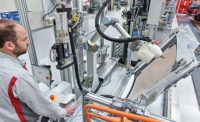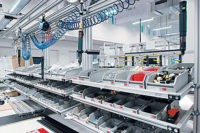Optimizing flow and minimizing waste are two of the basic elements of lean manufacturing. Those concepts also play a critical role in laying out assembly lines.
The way in which workstations and tools are arranged can affect ergonomics, productivity and throughput. Lean lines should accommodate increasing product variety without compromising quality or introducing waste into the process. Whether it’s a high-volume, low-mix environment or a low-volume, high-mix line, flexibility is critical.
Unfortunately, many manufacturers struggle with issues related to line layout. One reason is that products are changing more frequently today. Many engineers are reluctant to modify their assembly lines, because changing line layout tends to be quite disruptive.
“Producing more than one model simultaneously on an assembly line presents a number of challenges,” says Jeffrey Miller, P.E., managing principal at Productivity Engineering Services LLC. “Since the work content for each of the models will be different, this can lead to uneven flow along the line. Unless the line is properly balanced, you’ll end up with overstaffing or regularly scheduling overtime to meet customer demand.
“As model mix increases, so does the proliferation of parts and subassemblies that need to be presented line-side,” notes Miller. “Consequently, I see a lot of manufacturers struggling with the problem of how to best fit five pounds of stuff in a three-pound bag.
“It’s not an easy process, but this issue can be overcome with the proper material management system, such as implementing just-in-time kitting, sequencing and a small-lot strategy,” claims Miller. “But, [that] requires considerable upfront planning and know-how to get it right.”
Old or new, large or small; it doesn’t matter. Manufacturers in a variety of industries face similar line layout issues and challenges.
“There are a couple of problems I tend to see,” says Art Smalley, president of the Art of Lean Inc., and a former engineer at Toyota Motor Corp. “One is when new process or product lines are put into an old facility.
“Product flow is shoehorned into a space that is not optimal from the start,” explains Smalley. “This is done to save money on paper. But, it also tends to build in cost in reality, which is not fully understood up front. It contributes difficulty not only to the flow of product, but the flow of information, communication and daily supervision.
“Another problem, even in newer facilities, is to not fully plan out layouts in sufficient detail up front,” adds Smalley. “From the 10,000 foot level, things look fine. But, when actual movement of people, material, conveyance and product is put into place, problems jump out more clearly.”
Manufacturing engineers should be constantly tweaking assembly lines to maximize flow and minimize waste. In fact, this must be part of daily or weekly gemba walks.
“You should look for ways that waste has crept back into your line,” says Drew Locher, managing director of Change Management Associates. “The issues are often not related to the layout. Many times, operators are not following the standard work combination that the layout was designed on or standard work in process (WIP) rules.
“As a rule of thumb, if demand has changed—up or down in any substantial way—then you should carefully examine your line layout,” adds Locher. “It’s also important to do this if you’ve made any product design changes.
“Line layout is always about flow,” Locher points out. “That’s why you have to design the work combination first before you can design the layout.”
Common Mistakes
Manufacturing engineers often make several layout mistakes that impede the efficiency of assembly lines. Not designing in flexibility and not involving operators are two errors that should be avoided.
“Flexibility is always important,” claims Locher. “As long as it’s safe, try to put everything on wheels and use quick disconnects. If possible, lighting should be attached to workstations.
“In addition, some engineers don’t adequately involve operators in the line design process,” says Locher. “Whenever Toyota makes a layout change, they always get input from the people working on the line.”
It’s also important to consider material handling issues, such as parts storage, movement and conveyance.
“Equipment location is static, but material, people and information flow is dynamic and harder to visualize when working with layouts,” says Smalley. “Engineers tend to see the layout from the equipment point of view, while actual daily operations involve dynamic events that are harder to see on paper. It is like the difference between a photograph and a movie.”
“Many companies try to improve their process, but overlook the operations and vice versa,” adds Swapnil Yeole, lean sales engineer at Lean Factory America. “Some companies work on their operations and neglect the process.
“Processes focus on the flow of material,” explains Yeole. “Operations focus on actions performed by operators. Time spent in non-value-added activities, such as transportation time, material handling time, distances between workstations, inspection and rework, are all common mistakes.
“A lean-based approach (cellular manufacturing) works on minimizing the distances traveled for material in the facility,” says Yeole. “It stabilizes the lead time throughout the entire process, eliminates the problem of part shortages and focuses on reducing the WIP inventory.
“Traditional techniques, such as flow analysis, focus on material handling and space utilization but ignore batch size and high mix of products,” claims Yeole. “A lean approach helps companies achieve two important goals: one-piece flow and high production mix.”
Another pitfall to efficient layout is failing to take a big picture view by overlooking how the assembly line integrates with the overall plant layout. For example, if product flows from fabrication to paint to assembly to test to finished goods storage, then it’s important to determine where the assembly load and unload station is located relative to this flow.
“Establishing the optimum location is essential to avoid wasted transportation, excess inventory and accomplishing synchronous manufacturing,” says Miller. “I’m a big advocate of conducting a proper material flow and product flow analysis, such as a spaghetti diagram, to help guide this decision.”
According to Miller, another common line layout mistake that engineers make is “putting the CAD cart before the horse. It’s tempting to start developing a CAD layout before you’ve done your homework,” he points out.
“However, I discourage [engineers] from doing that,” says Miller. “When it comes to painting your house, approximately 80 percent of a professional paint job is in the preparation. Similarly, sufficient prep work is key to achieving a successful assembly line layout.
“That includes creating a crossfunctional team, establishing specific goals and objectives, collecting data on volumes, model mixes, work content, cycle times, downtimes, part packaging and developing process flow charts,” explains Miller. “Diving into the CAD design without following a robust design methodology can yield a half-baked solution that requires costly re-engineering post installation.”
Involve Operators
Crossfunctional design teams should include key players from the production crew. “These folks have a wealth of tribal knowledge,” Miller points out. “Capturing how the products are actually built, the operating methods used to get things done, and issues and shortcomings of the current layout are invaluable nuggets of information needed for the successful design of the future state layout.
“Fostering active involvement and participation of key associates not only leads to a better line balance and layout solution, but also there will be much less resistance when it comes time to implementing the plan,” notes Miller. “[Operators] will take ownership of the layout they helped develop.”
“Putting the customer first and having a good understanding of the market, such as developing or changing expectations, paired with a systematic and holistic approach will yield the best overall results,” adds Andreas Hassold, connected industry consultant at Bosch Rexroth Corp.
“Elements such as life cycle planning, flow-oriented layout, risk analysis and value stream design need to work in concert,” says Hassold. “Early integration of operators is paramount for acceptance in the ramp up of new processes and technologies and will provide critical insights to line development.”
A lean-based approach to line layout differs from traditional techniques. For instance, lean layouts often use some type of an andon system to address issues such as production status, quality checks and abnormalities.
Lean layouts also rely heavily on product and process planning (3P) methodologies.
“We call it production preparation,” says David Pate, vice president of TBM Consulting Group. “It involves layout design that can apply to either an individual workcell or an entire plant.”
According to Pate, any layout project using this method should address the following criteria:
- Enable material flow to and from the line.
- Allow people to interface easily and quickly in a flexible environment.
- Ensure that all equipment is as versatile as possible.
- Don’t create monuments. “Smaller, moveable equipment is better than large, monolithic items,” claims Pate.
- Make it easy to change over.
- Minimize wasted motion.
- Separate people and machines.
- Enable the use of pull systems.
“Another best practice for creating a lean layout is using a lineside-back approach to designing the material flow process,” says Miller. “This requires a detailed plan for every part, starting with the operator, then working back through the pipeline to the supplier with the goal of eliminating waste and supporting the operator.
“Waste at the workstation can be eliminated by presenting parts and equipment in an operator friendly manner,” claims Miller. “To present all the material within the station envelop, several techniques can be exploited. One is to use small modular containers displayed on gravity flow racks or customized pipe-and-joint presentation devices.
“In cases where there’s too many variants to fit within the station or the parts are too large to fit in a small container, they can be presented to the operator in a sequenced cart,” explains Miller. “This allows the operator to get all parts from a single location, as opposed to walking and searching amongst several different large bulk containers.”
Kitting parts is also commonly used in lean layouts. This technique improves part presentation to the operator, reduces wasted motion and eliminates line-side inventory. It also lowers the mental burden, thereby improving quality by minimizing the chance of installing the wrong part.
To learn more about lean layout issues, trends and challenges, check out the following ASSEMBLY articles:








